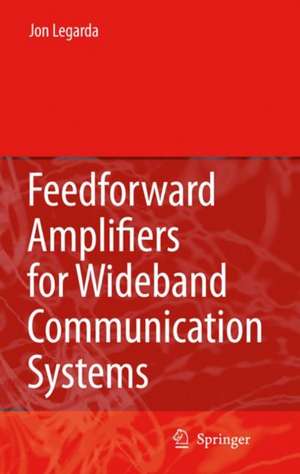Feedforward Amplifiers for Wideband Communication Systems
Autor Jon Legardaen Limba Engleză Hardback – 29 sep 2006
The wireless telecommunications are more and more demanded for the Information Society. Such requirements are reflected as a great many of communication standards with specific coverage applications and, above all, with higher and higher data transmission rates.
The electromagnetic spectrum, nevertheless, is a scarce asset that can not be spread and despite the increasingly tendency to transmit in higher frequencies, the bandwidths assigned to each application are always exploited to the limit.
Feedforward Amplifiers for Wideband Communication Systems merges in the need of developing frequency efficient modulations with widespread codification techniques that result in wideband communication systems, with strict regulations in the usable frequency bandwidths and tight restrictions in the spurious emissions over the remaining spectrum.
The radio frequency transmitters do not remain impassive to those changes, especially the power amplifiers, which efficiency and linearity directly determines the correct performance of the entire transmission system. The linearity specifications are commonly fixed by the telecommunication standards while the efficiency rates directly strikes the commercial viability of these transmitters.
Feedforward Amplifiers for Wideband Communication Systems tries to put into practice the Feedforward linearization technique, aimed at improving either the linearity or efficiency parameters of power amplifiers, just intended for achieving a trade-off between the distortion specifications of the telecommunication standards and the efficiency enhancement of the transmission systems, which set, respectively, the linearity and the output level requirements of power amplifiers.
This challenge is enshrined in one of the present wideband communication systems, but all the recommended design guidelines are perfectly reusable in the future wideband applications.
| Toate formatele și edițiile | Preț | Express |
|---|---|---|
| Paperback (1) | 636.12 lei 6-8 săpt. | |
| Springer Us – 29 oct 2010 | 636.12 lei 6-8 săpt. | |
| Hardback (1) | 641.71 lei 6-8 săpt. | |
| Springer Us – 29 sep 2006 | 641.71 lei 6-8 săpt. |
Preț: 641.71 lei
Preț vechi: 754.95 lei
-15% Nou
Puncte Express: 963
Preț estimativ în valută:
122.81€ • 127.88$ • 103.79£
122.81€ • 127.88$ • 103.79£
Carte tipărită la comandă
Livrare economică 07-21 martie
Preluare comenzi: 021 569.72.76
Specificații
ISBN-13: 9780387351377
ISBN-10: 038735137X
Pagini: 178
Ilustrații: XVIII, 178 p.
Dimensiuni: 156 x 234 x 13 mm
Greutate: 0.45 kg
Ediția:2006
Editura: Springer Us
Colecția Springer
Locul publicării:New York, NY, United States
ISBN-10: 038735137X
Pagini: 178
Ilustrații: XVIII, 178 p.
Dimensiuni: 156 x 234 x 13 mm
Greutate: 0.45 kg
Ediția:2006
Editura: Springer Us
Colecția Springer
Locul publicării:New York, NY, United States
Public țintă
Professional/practitionerCuprins
Dedication. Preface. Acknowledgments.- 1. Introduction.- Radio-Electric transmitters - Historical overview.- Digital communication systems.- Digital modulation.- 2. Nonlinear distortion.- Harmonic distortion.- Intermodulation analysis.- Cross modulation (XMOD).- Distortion measurement techniques.- Measurements of wideband digital signals.- 3. RF power amplifiers.- Classification of power amplifiers.- Power amplifiers parameters.- Class A.- Class B.- Class AB (outphasing).- Class C.- Switching amplifiers.- More operating modes.- 4. Linearization techniques.- Classification of the linearization techniques.- Feedback.- Predistortion.- Feedforward.- Efficiency enhancement techniques.- Comparison of linearization techniques.- 5. Feedforward amplifiers.- Feedforward linearization technique.- Feedforward in wideband communications systems.- 6. Implementation of Feedforward amplifiers.- Simulation of the Feedforward architecture.- Selection of the error amplifier.- The adjustment of the cancellation loops.- Distortion enhanced measurement techniques.- Improvements of Feedforward amplifier.- 7. Adaptive Feedforward amplifiers.- Adaptive adjusting methods for Feedforward amplifiers.- Distortion monitoring architectures.- An output signal monitoring architecture.- The adaptive Feedforward amplifier.- Conclusions.
Caracteristici
Some guidelines are proposed for the implementation of Feedforward amplifiers Basic measurement techniques are recommended for the characterization of high linear devices Some design rules are provided to develop a distortion monitoring system for the adaptive control system of a Feedforward amplifier













